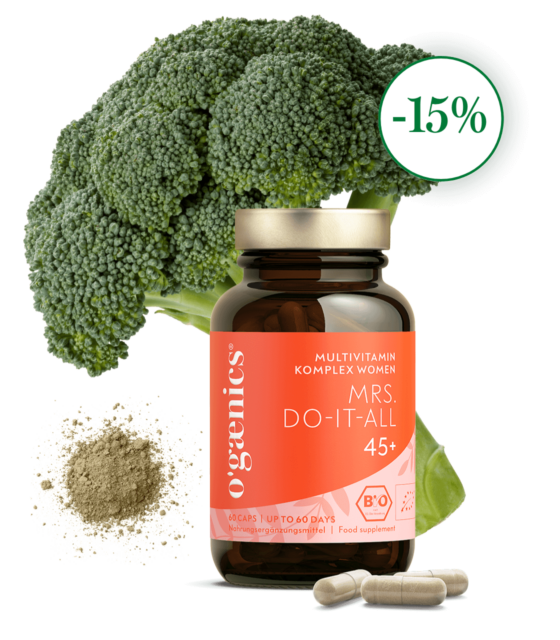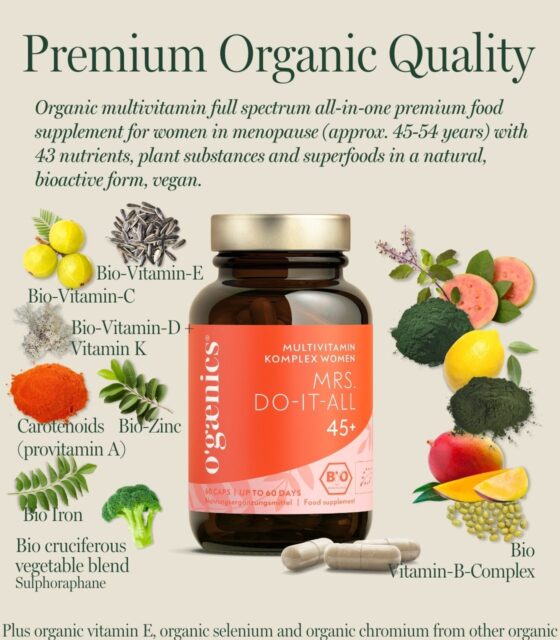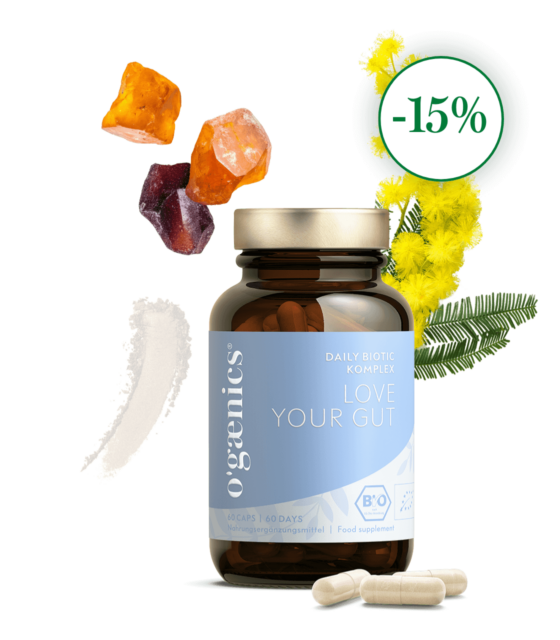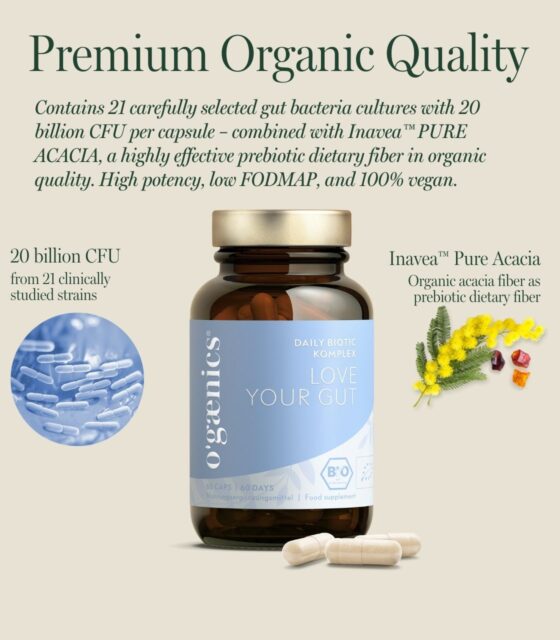How to balance your hormones if you have estrogen dominance.
Painful periods and intense PMS are often considered “normal”. But behind this is usually a hormonal imbalance. Today we’re going to take a closer look at estrogen dominance – more specifically, what it is and how you can naturally and holistically manage the uncomfortable symptoms that come with it.
Before we get into estrogen dominance, it is important to understand what hormones actually are. Hormones are messenger substances that send signals to the organs and tell them what to do. When we have too little or too much of a hormone, our organs don’t get the proper signals our bodies need to function optimally.
What is estrogen?
Estrogen and progesterone are the two most important female sex hormones. They have many different roles in the body and are equally important in achieving and maintaining optimal health.
Estrogen is the hormone produced mainly in the ovaries and plays an important role in the menstrual cycle. It signals the uterine lining to grow and thicken in preparation for pregnancy. Estrogen also affects sexual desire, sexual response, brain function and bone density. It also has effects on the function of the thyroid gland, hypothalamus, anterior pituitary, thymus, skin and nervous system.
Progesterone also causes the uterine lining to grow and thicken in preparation for pregnancy. When fertilization does not occur, progesterone levels drop, signaling the beginning of the menstrual cycle. Progesterone also reduces cell growth, especially breast cells, reduces anxiety and depression, promotes sleep, affects bone growth, and increases the activity of thyroid hormone, which affects metabolism.
What are the symptoms of estrogen dominance?
Estrogen dominance can manifest itself in several ways. Symptoms are often nonspecific and therefore often not associated with hormonal imbalance. Possible signs of estrogen dominance include:
- Allergies
- PMS
- Dry skin
- Headache
- Fatigue
- Anxiety/mood swings
- Infertility
- Miscarriage
- Low libido
- Difficult weight loss
- Excessive hair growth on the body
- Endometriosis
- Ovarian cysts
- Varicose veins (varices)
- Uterine fibroids
- Breast Tension
- Fluid accumulation
- Hypoglycemia
- Fat accumulation on the hips, thighs and in the abdominal area
- Osteoporosis
- Altered thyroid activity (mimics hypothyroidism).
- Heavy and irregular menstruation
Estrogen dominance and its causes
Estrogen dominance is exactly what it sounds like. It is a hormonal imbalance that occurs when estrogen levels in the body are higher than they should be and “dominate” other hormones such as progesterone.
Stress
The main cause of estrogen dominance is stress. Excessive and/or prolonged stress reduces progesterone production to instead produce more cortisol, the main stress hormone. This results in high estrogen levels relative to progesterone. You can learn suitable strategies for reducing stress in our article“Lowering cortisol: How to beat stress and fatigue”.
Impaired liver function
Another cause may be
impaired liver function
can be. The liver has the task of removing excess hormones from the body. When the liver is impaired, it can no longer perform this task, resulting in estrogen dominance. You can find out how to relieve and strengthen your liver in our article “Detox in everyday life”.
A dysbiosis in the intestine
Dysbiosis in the gut
where there are more harmful bacteria than good bacteria, can inhibit the conversion of oestrogen into water-soluble molecules. This causes the estrogens to re-enter the bloodstream, where they can once again exert their effect. Gut health is critical for the metabolism of all hormones.
Xenoestrogens
Xenoestrogens are synthetic chemicals that mimic estrogen in the body. These can be found in personal care products, plastics and pesticides. However, unlike endogenous estrogen, xenoestrogens are stored in fat cells, where they disrupt the proper functioning of the reproductive system and increase the risk of breast and ovarian disease.
Growth hormones
Growth hormones in meat and milk from conventionally raised animals may contain estrogen because estrogen is present in these hormones. To avoid this, meat and dairy products should be consumed exclusively from controlled organic farming or a vegan diet should be adopted.
Hormones in drinking water
Hormones in drinking water are another potential source of estrogen exposure. Even the best drinking water often contains hormones that cannot be filtered out by wastewater treatment plants. To avoid this, it is advisable to invest in a high-quality water filter for your home or have spring water delivered in glass bottles.
Chemicals in personal care products
Personal care products such as cosmetics, shampoos, hair creams and body lotions can contain harmful chemicals. A common chemical in such products is “fragrance,” which has been linked to liver and kidney damage, cancer, and hormonal imbalances. Opt for natural, plant-based alternatives with simple ingredients and use apps like Codecheck to track down potentially hormone-disrupting substances in your beauty products.
Nutrition
Your diet and lifestyle also have a big impact on hormone balance. An unhealthy diet with too much sugar, carbohydrates, animal fats or non-fermented soy products can increase oestrogen levels or prevent the excretion of excess oestrogen.
Overweight
Obesity is another risk factor for estrogen dominance. This is because fat cells can not only store energy, but also produce hormones. The more fatty tissue there is, the more estrogen is produced.
Oestrogen dominance – what helps against it
There are numerous lifestyle and dietary changes that can have a significant impact on the symptoms of estrogen dominance. Here are some of our best recommendations:
1. increase your fiber intake
To detoxify excess estrogen, it’s crucial to include enough fiber in your diet. Dietary fiber is a natural compound that binds estrogen excreted by the liver and promotes its removal to the digestive tract, while preventing the reabsorption of estrogen.
It is easy to achieve this goal with a balanced diet. Examples of high-fiber foods include broccoli, pears, lentils, and ground flaxseeds. If you want to increase your fiber intake, consider incorporating oatmeal, oat bran or psyllium husks a few times a week. Psyllium husk powder (200 mg daily) along with sufficient water may also be helpful.
2. improve your digestion
Healthy digestion is crucial for hormone balance. Make sure you eat enough fiber to bind and eliminate excess estrogen. Regular bowel movements, at least once a day, are also important.
For digestive or liver problems, certain herbs such as milk thistle, dandelion, artichoke and mint can be supportive. These herbs protect the liver, promote detoxification and facilitate digestion. You can take them as tea, salad, juice or capsules. If your bowel movements are dry and hard, increase your fluid intake to 2.5 liters of purified water per day to rid the body of toxins and excess estrogen.
3. increase the intake of probiotics
Foods rich in probiotics are essential for gut health, energy production, healthy skin and hormone metabolism. They also promote a balance of good bacteria in the gut, which reduces the risk of estrogen being converted by harmful bacteria in the bloodstream and promotes regular bowel movements.
Probiotic-rich foods include fermented vegetables like kimchi and sauerkraut, kefir, apple cider vinegar, natural kombucha (watch for low sugar content), and organic tempeh and miso. These foods contain beneficial bacteria that promote intestinal health and support the liver’s detoxification function.
Alternatively, you can take probiotics as a dietary supplement. An excellent product that offers daily probiotic support while providing valuable fiber is Ogaenics LOVE YOUR GUT Daily Biotic Complex.
4. healthy fats support healthy hormones
Incorporate into your diet foods like avocados, walnuts, olive oil, coconut products, nuts and seeds. Flaxseeds in particular, which contain lignans, can balance hormone metabolism and block the negative effects of excess estrogen.
5. reduce stress
Stress can increase cortisol production, a hormone that inhibits the breakdown of estrogen and thus can contribute to estrogen dominance. Find time to relax and take regular time-outs for yoga, meditation, breathing exercises or other relaxation techniques.
6. abstain from alcohol and caffeine
Alcohol stresses the liver and can interfere with the detoxification of estrogen. Caffeine can deplete the adrenal glands and lead to an increase in estrogen levels. Replace alcohol and caffeine with water, smoothies and herbal teas, especially those with dandelion and milk thistle, to help the liver detoxify.
7. general rules of nutrition
It is important to prefer fresh, organic, raw or lightly cooked products. Meat, poultry and dairy products should come from certified organic farms, but should be enjoyed in limited quantities. Reduce consumption of commercial wheat and instead choose organic wheat or sprouted/fermented varieties like sourdough. Replace refined sugar with natural sweeteners like dates, honey or maple syrup, but in moderation. Drink plenty of clean, filtered water and make sure you get fiber at every meal. Remember that estrogen is excreted through the intestines, so a good bowel movement is crucial.
8. watch out for phytoestrogens
Phytoestrogens are plant compounds with a similar structure to estrogen, but with weaker estrogenic effects in the body. They can help reduce estrogenic activity and counteract estrogen dominance. Examples of phytoestrogens include oats, alfalfa, lentils, barley, apples, sweet potatoes, carrots, sesame seeds, licorice root, red clover, and soy products.
You need these nutrients for oestrogen dominance
The most effective way to bring about rapid and profound changes is to combine nutritional optimization with targeted nutritional supplementation. Your diet is the foundation for hormone balance, whereas supplements can support and accelerate this process.
These three supplements you need for your hormone balance
-
Bestseller
Mrs Do-It-All 45+
Organic Multivitamin Complex Premium for menopausal women, All-In-One!67,92 €79,90 €1.997,50 €1.698,00 € / kg -
Bestseller
Love Your Gut
Bio Daily Biotic Complex Premium for the gut: 21 bacterial strains plus organic fiberab 33,92 € -
Bestseller
Calm A Lama
Plant-based organic magnesium from premium organic green algae extract for muscles and nerves38,17 €44,90 €1.076,74 €915,35 € / kg
Vitamin D3
Vitamin D3 plays a crucial role in the regulation of estrogen levels and strengthens the immune system. Recommendation: 1,000-2,000 IU daily (higher doses only after blood testing and temporarily). You can find vitamin D3 from organic plants in HELLO SUNSHINE Vitamin D plus K2 and in all Ogaenics multivitamins.
Vitamin C
Studies show that women who take vitamin C have higher levels of progesterone, which counteracts estrogen dominance. You’ll find vitamin C from organic plants in Healthy Kick Plant-Based Vitamin C, for example, and in all of Ogaenics’ multivitamins.
Vitamin B6
This vitamin promotes the production of progesterone, helps counteract excess estrogen. It supports liver function and helps reduce estrogen dominance. Recommendation: At least 1.3 mg daily for adults and 1.7 mg over age 50 (e.g., B-HAPPY Vitamin B Complex or in all Ogaenics multivitamins).
Sulforaphane
Sulforaphane is found in cruciferous vegetables and is a powerful detoxifier for the liver. It promotes detoxification of the body, has long-lasting antioxidant and anti-inflammatory properties. You’ll find an organic cruciferous blend in the MRS DO-IT-ALL 45+ Organic Multivitamin.
Probiotics
Probiotics contain “good” bacteria that inhibit the growth of harmful bacteria and rebalance the intestinal flora in cases of dysbiosis. Recommendation: 20 billion probiotics daily (e.g. LOVE YOUR GUT Daily Biotic Complex from Ogaenics).
Magnesium
Magnesium plays an important role in hundreds of enzyme reactions that affect natural hormone balance and helps the liver detoxify excess estrogen. Recommendation: Natural magnesium, such as in CALM A LAMA Plant-Based Magnesium from Ogaenics, is easily absorbed and has no laxative side effects. Daily 1-2 capsules.
If you want to learn even more about the effects of magnesium, also read our article “The magnesium effect: 9 reasons why you should love the mineral” and learn how important this mineral is for your health. In addition, the article “Magnesium Deficiency: Causes, Symptoms and Solutions” offers insights into the typical symptoms of magnesium deficiency and what you can do about them.
Conclusion
Estrogen dominance is not an unalterable fate, but a treatable condition. By eating right, making adjustments to your daily routine, and using supplements in a targeted way, you can balance your hormones and improve your quality of life.








 No products in the cart.
No products in the cart.